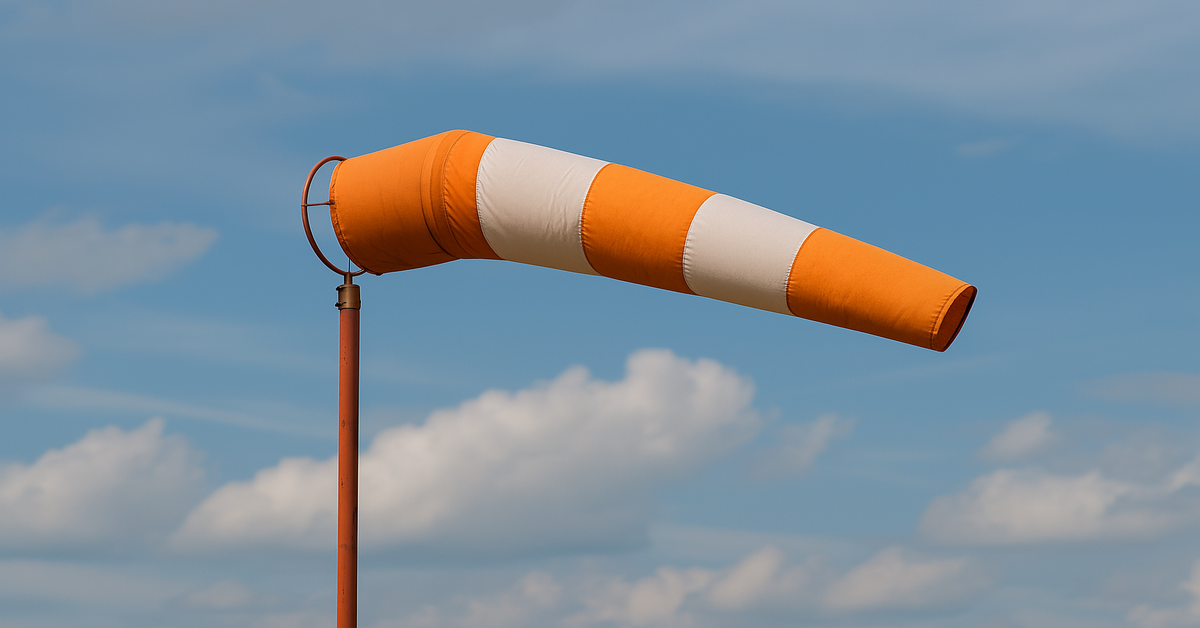In the realm of aviation, meteorology, and even industrial environments, the windsock remains an iconic and vital tool for assessing wind direction and relative speed. Despite its simple design, a windsock plays a critical role in safety, efficiency, and environmental monitoring. Whether seen at airports, chemical plants, or weather stations, this tapered fabric tube has a story, a purpose, and a sophisticated functionality that goes beyond its apparent simplicity.
This article explores the history, mechanics, applications, and evolution of the windsock. We’ll delve into how it works, where it is used, standards that govern its design, and why it continues to be relevant in a technologically advanced world.
What Is a Windsock?
Basic Definition
A windsock is a conical textile tube designed to indicate wind direction and estimate wind speed. It is typically mounted on a tall pole and freely rotates to align with the prevailing wind. The open end of the windsock catches the wind, inflating the tube, while the narrow end points away from the source of the wind.
Components of a Windsock
- Fabric Tube: Usually made of nylon or polyester, designed to withstand UV rays and varying weather conditions.
- Mounting System: A swivel mechanism allows the windsock to rotate 360 degrees.
- Support Frame: Often includes a hoop to keep the mouth open for wind intake.
- Heighted Pole: Ensures visibility from a distance.
History of the Windsock
Origins
The concept of using cloth to detect wind direction can be traced back to ancient China and Japan. Samurai used similar tools in battle to determine wind direction for strategic purposes.
Evolution Over Time
In modern history, windsocks became prevalent during World War I and II for use in aviation. Airfields needed a quick and visual way for pilots to understand wind conditions for takeoffs and landings. Today, while digital instruments are widespread, the windsock continues to serve as an indispensable visual tool.
How Windsocks Work
Wind Direction
The primary function of a windsock is to show the direction the wind is blowing from. It does this by aligning itself with the wind flow— the wide end facing into the wind and the narrow end trailing behind.
Wind Speed Estimation
Though not as precise as digital anemometers, windsocks provide a visual indication of wind speed:
- If the windsock droops, wind speed is low.
- If the windsock is partially extended, wind is moderate.
- If fully extended, wind speed is strong.
Some designs include rings or stripes, each representing a specific wind speed increment (e.g., 3 knots per stripe).
Types of Windsocks
Standard Windsocks
Commonly used at airfields, these windsocks are large, visible from great distances, and adhere to aviation standards.
Industrial Windsocks
Used in chemical and oil refineries, these are essential for identifying the direction of hazardous gas leaks.
Decorative Windsocks
Found in gardens or as festive decorations, these serve an aesthetic rather than functional purpose.
Portable Windsocks
Ideal for temporary airstrips, construction zones, and remote areas where permanent installation is impractical.
Applications of Windsocks
Aviation
Airports and airfields are the most common locations for windsocks. Pilots rely on them for immediate, visual assessment of wind conditions during takeoff and landing.
Meteorology
Weather stations use windsocks as part of a broader set of instruments to monitor wind behavior.
Industrial Safety
Chemical plants, oil refineries, and other hazardous environments use windsocks to monitor wind direction in case of gas or vapor leaks.
Agriculture
Farmers use windsocks to make informed decisions about spraying pesticides or planning controlled burns.
Sports and Recreation
Used in paragliding, kite flying, and sailing, where wind awareness is crucial for performance and safety.
Windsock Materials and Durability
Common Materials
- Nylon: Lightweight and durable, commonly used in aviation.
- Polyester: More UV-resistant than nylon.
- Cotton (decorative): Used for aesthetic windsocks, not recommended for functional uses.
Weather Resistance
Modern windsocks are designed to resist:
- Ultraviolet radiation
- Heavy rain
- Strong winds
- Chemical exposure (in industrial settings)
Proper material selection ensures that the windsock remains functional and visible for years.
Installation and Maintenance
Placement Guidelines
- Height should provide maximum visibility.
- Should be placed away from obstructions that may affect wind patterns.
- Typically installed at both ends of an airstrip.
Maintenance Tips
- Inspect fabric for tears or fading.
- Lubricate swivel joints periodically.
- Replace worn components promptly.
Routine maintenance ensures continued accuracy and reliability.
Windsock Standards and Regulations
FAA and ICAO Guidelines
The Federal Aviation Administration (FAA) and International Civil Aviation Organization (ICAO) have set specific guidelines for windsocks:
- Length: Typically 8 to 12 feet for aviation.
- Color: Usually orange for visibility.
- Performance: Must respond to winds as low as 3 knots.
- Lighting: Required for nighttime use at airports.
OSHA Requirements
In industrial applications, the Occupational Safety and Health Administration (OSHA) may require windsocks as part of an emergency response plan.
Innovations in Windsock Design
LED-Illuminated Windsocks
These windsocks include built-in LED lighting for nighttime visibility, crucial for 24/7 operations.
Electronic Windsocks
Equipped with sensors, these provide digital readouts of wind speed and direction in addition to the traditional visual cue.
High-Visibility Patterns
Some windsocks now feature alternating color bands for better visual distinction from long distances.
Buying Guide: Choosing the Right Windsock
Factors to Consider
- Purpose: Aviation, industrial, or decorative?
- Size: Larger sizes for aviation, smaller for recreational use.
- Material: Polyester for UV resistance, nylon for durability.
- Mount Type: Ground-based, rooftop, or portable stands.
Recommended Brands
- Delta Scientific
- Safety Flag Co. of America
- Wind-Tek
Always ensure the product meets regulatory standards relevant to your application.
Future of Windsocks
Integration with Smart Technology
Future windsocks may integrate with weather monitoring systems, offering real-time updates via Wi-Fi or Bluetooth.
Sustainable Materials
Eco-friendly fabrics made from recycled plastics are being explored to make windsocks more sustainable.
Enhanced Accuracy
Incorporating sensors to enhance the estimation of wind speed could make windsocks more than just a visual tool.
Despite technological advances, the basic windsock design remains effective and irreplaceable in many scenarios.
Conclusion
The windsock, though simple in design, continues to play a crucial role across various sectors. From guiding pilots during critical takeoff procedures to alerting chemical plant workers of potential hazards, its function transcends industries. By understanding how it works, where it applies, and how it is maintained, we can appreciate its ongoing relevance in both traditional and modern settings.
As technology continues to evolve, so too will the humble windsock, integrating new features while maintaining its core function—visually interpreting the wind. This simple device teaches us that sometimes, even in a digital world, analog tools remain indispensable.
FAQS
1. What is the purpose of a windsock?
A windsock is used to show the direction and approximate speed of the wind, essential for aviation and safety applications.
2. How do you read a windsock?
The wide end faces the wind, and the narrow end points in the direction the wind is blowing. The more it inflates, the stronger the wind.
3. Are windsocks still used in modern airports?
Yes, despite advanced instruments, windsocks remain vital for visual wind assessment by pilots.
4. Can I install a windsock at home?
Absolutely. They are popular in gardens, on boats, or in private airstrips.
5. What materials are best for windsocks?
Nylon and polyester are preferred for durability, weather resistance, and visibility.
6. Do windsocks need maintenance?
Yes. Regular inspection for wear and tear, along with occasional lubrication of moving parts, ensures long-term usability.











